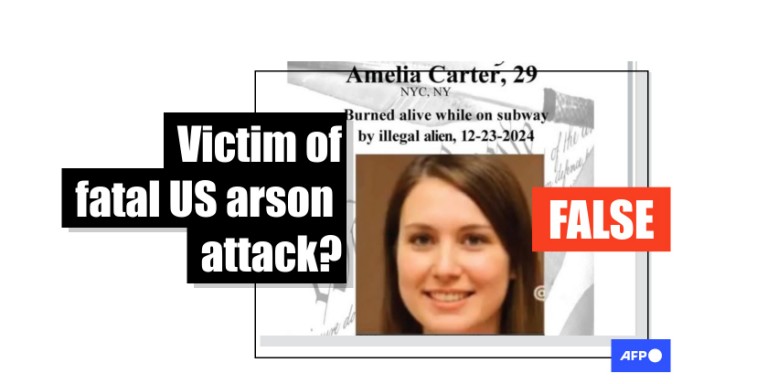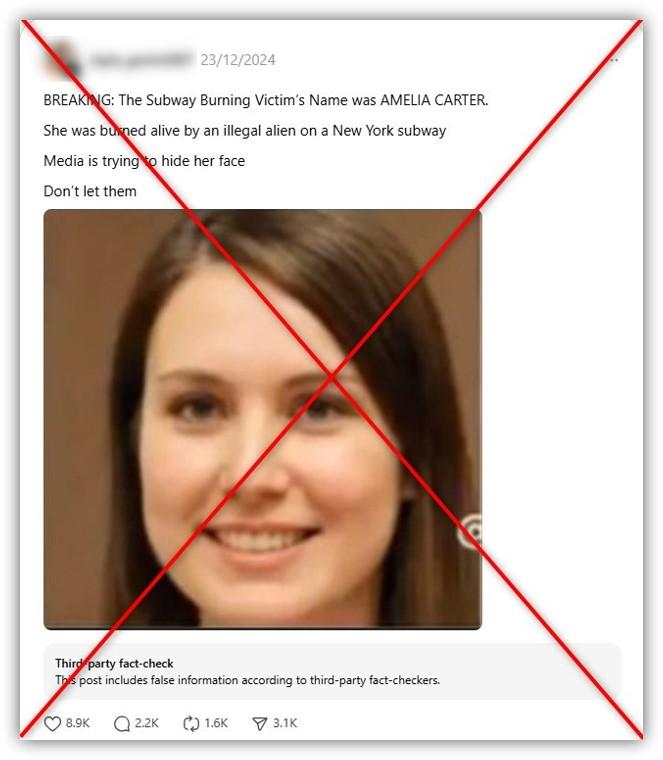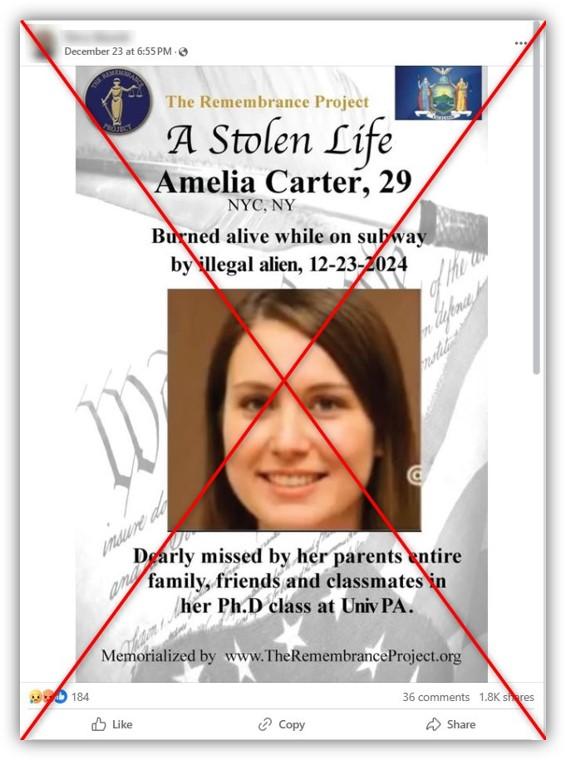
Hoax posts misidentify woman burned alive on New York subway
- Published on December 31, 2024 at 19:23
- Updated on December 31, 2024 at 21:12
- 4 min read
- By Bill MCCARTHY, AFP USA
"BREAKING: The Subway Burning Victim’s Name was AMELIA CARTER," says a December 23 post on Threads. "She was burned alive by an illegal alien on a New York subway. Media is trying to hide her face. Don’t let them."

Similar posts -- many taking aim at US President Joe Biden's immigration policies -- spread in English and Spanish across Threads and other platforms, including Facebook, Instagram and X.
Several posts further claimed to show the image of "Amelia Carter" in a graphic from the Remembrance Project, a group that memorializes Americans killed by undocumented immigrants.
The apparent poster says she would be "dearly missed by her parents entire family, friends and classmates in her Ph.D. class at Univ PA," a presumed reference to the elite University of Pennsylvania, where some other posts said "Amelia Carter" was in school. It mistakenly says the subway attack happened December 23.

The "Amelia Carter" narrative relates to the death on December 22 of a woman who was set on fire and engulfed in flames while sleeping aboard the F train in Brooklyn, New York. Authorities charged Sebastian Zapeta-Calil, a 33-year-old Guatemalan citizen who entered the US unlawfully, with murder and arson for allegedly igniting the woman's clothes.
The incident came amid elevated concerns about safety on the city's public transit system. Weeks earlier, a jury found former US Marine Daniel Penny not guilty in the 2023 chokehold death of Jordan Neely, a Black homeless man, on the subway.
It also followed President-elect Donald Trump's election victory after a campaign that was heavily focused on immigration at the southern US border with Mexico.
But the posts honoring "Amelia Carter" misidentify the victim of the arson attack. The image appears to be a fake created by artificial intelligence technology, three media forensics experts told AFP.
The New York Police Department identified the true victim as Debrina Kawam of Toms River, New Jersey, its public information office told AFP in a December 31 statement.
The injuries to Kawam, who was reportedly homeless, had prolonged the identification process for more than a week. The investigation of her identity was still "pending" as of December 30, the police told AFP.
Julie Bolcer, a spokesperson for the New York chief medical examiner's office, told AFP the medical examiner confirmed Kawam's identity on December 30 through fingerprint analysis. Bolcer said Kawam was 57 years old, though police initially reported her age as 61.
The social media posts naming "Amelia Carter" as the deceased are "incorrect," Bolcer said.
Ron Ozio, director of media relations for the University of Pennsylvania, told AFP that contrary to the claims online, the woman burned alive "was not a Penn student."
A representative for the Remembrance Project also pointed to its actual December 23 post about the incident, which did not name the victim as "Amelia Carter" but instead memorialized an unnamed "innocent citizen" (archived here).
AI-generated image
Hany Farid, a media forensics expert with the University of California-Berkeley, told AFP the "Amelia Carter" picture spreading online has "tell-tale signs of being a GAN-generated image," such as those created by the website thispersondoesnotexist.com (archived here).
GAN stands for Generative Adversarial Network, a type of machine learning model often used to create hyper-realistic images of faces.
"In particular, the tightly-cropped headshot, non-descript background and alignment of the eyes are consistent with a GAN-generated face," Farid said, pointing to his online tip sheet for recognizing deepfakes (archived here).
Siwei Lyu, director of the University at Buffalo's Media Forensic Lab, and Walter Scheirer, a professor of engineering at the University of Notre Dame, agreed that the image resembles other GAN-generated faces (archived here and here).
Lyu said his detection models matched it to a GAN model with nearly 100 percent confidence.
He said most GAN-generated images place the eyes at roughly the same heights. When he lined up the "Amelia Carter" portrait next to other known deepfakes, the eyes were located at similar positions.
Scheirer added that the pupils in the "Amelia Carter" image appear mismatched.
"The right pupil is oddly shaped, which is a tell-tale sign of a GAN-generated image."
He also noted that reverse image searches surfaced only scattered social media posts misidentifying the subway fire victim.
"If this was a real person, there would likely be some online presence," Scheirer said.
A crypto token
Indeed, reverse image searches revealed the supposed "Amelia Carter" portrait was posted to X as early as December 22 by the user "@minnie1254," who shared it along with a statement purportedly released by her family.

A keyword search for the text of the supposed family statement uncovered two meme coins on a cryptocurrency trading platform called pump.fun. The tokens are titled "Justice For Amelia (AMELIA)" and "AMELIA CARTER (AMELIA)."
The meme coins were created within a minute of each other on December 22 -- and less than five minutes after the post from "@minnie1254" on X. The pump.fun pages for both coins link directly to the "@minnie1254" X account.
AFP reached out to the account via an X direct message, but no response was forthcoming.
AFP has debunked other AI-generated visuals here.
This article was updated to include a statement and information provided by the New York chief medical examiner's officeDecember 31, 2024 This article was updated to include a statement and information provided by the New York chief medical examiner's office
Copyright © AFP 2017-2025. Any commercial use of this content requires a subscription. Click here to find out more.
Is there content that you would like AFP to fact-check? Get in touch.
Contact us




